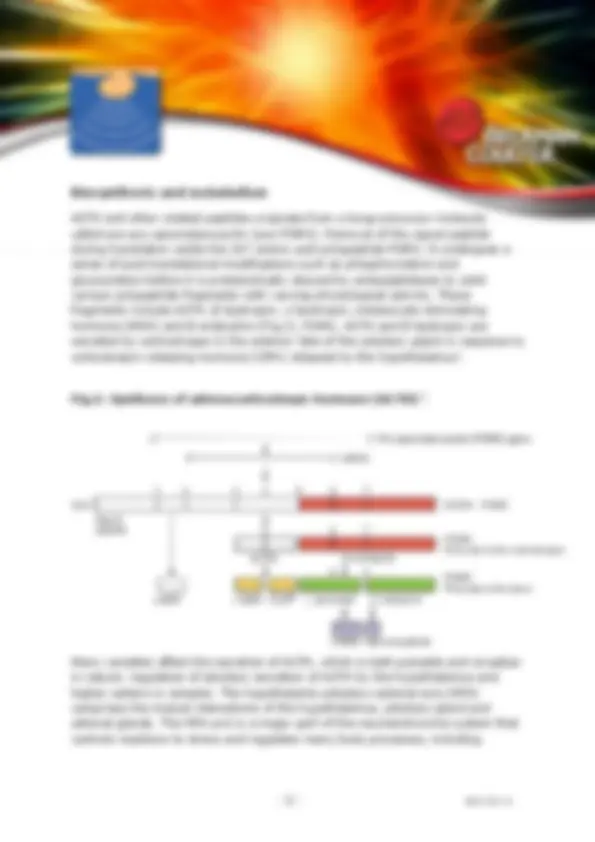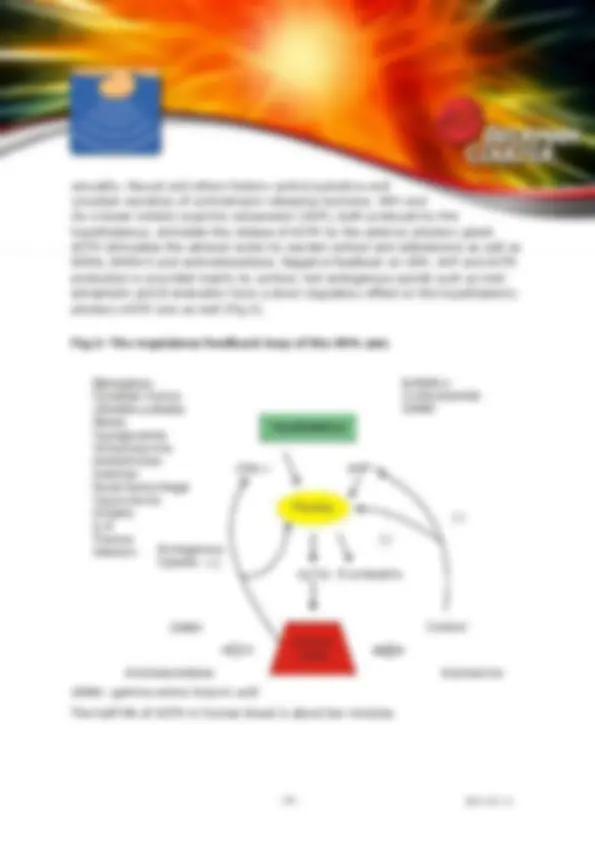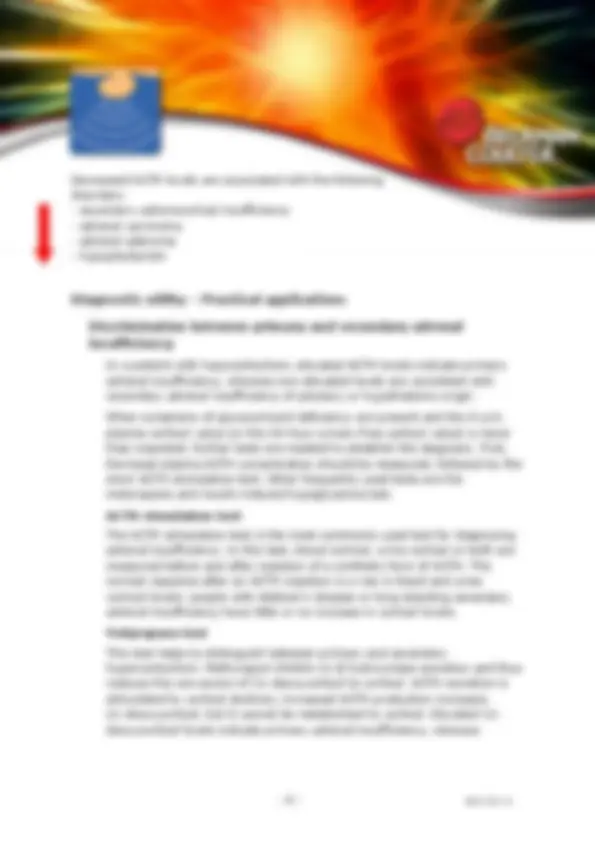








Study with the several resources on Docsity

Earn points by helping other students or get them with a premium plan


Prepare for your exams
Study with the several resources on Docsity

Earn points to download
Earn points by helping other students or get them with a premium plan
Community
Ask the community for help and clear up your study doubts
Discover the best universities in your country according to Docsity users
Free resources
Download our free guides on studying techniques, anxiety management strategies, and thesis advice from Docsity tutors
Adrenocorticotropic hormone, as its name implies, stimulates the adrenal cortex. More specifically, it stimulates secretion of glucocorticoids ...
Typology: Schemes and Mind Maps
1 / 11

This page cannot be seen from the preview
Don't miss anything!







Analyte Information
Adrenocorticotropic hormone (ACTH) is a polypeptide tropic hormone produced and secreted by the anterior pituitary gland. Adrenocorticotropic hormone, as its name implies, stimulates the adrenal cortex. More specifically, it stimulates secretion of glucocorticoids such as cortisol, and it also has certain effects on the secretion of aldosterone. ACTH also partially regulates adrenal androgen production of both dehydroepiandrosterone (DHEA) and androstenedione.
ACTH has a molecular weight of 4.54 Da.
ACTH is single chain polypeptide composed of 39 amino acids. Twenty-four N- terminal amino acids are necessary for the biological activity of ACTH and are the same across all species, whereas 15-C terminal amino acids are very variable (Fig. 1).
Fig.1: The structure of human ACTH
Adrenocorticotropic hormone is also known as corticotrophin, adrenocorticotrophin and adrenocorticotrophin hormone.
sexuality. Neural and others factors control pulsative and circadian secretion of corticotropin-releasing hormone. CRH and (to a lesser extent) arginine vasopressin (AVP), both produced by the hypothalamus, stimulate the release of ACTH by the anterior pituitary gland. ACTH stimulates the adrenal cortex to secrete cortisol and aldosterone as well as DHEA, DHEA-S and androstenedione. Negative feedback on CRH, AVP and ACTH production is provided mainly by cortisol, but endogenous opoids such as met- enkephalin and β-endorphin have a down-regulatory effect on the hypothalamic- pituitary-ACTH axis as well (Fig.3).
Fig.3: The regulatory feedback loop of the HPA axis
GABA: gamma amino butyric acid
The half-life of ACTH in human blood is about ten minutes.
ACTH acts through the stimulation of cell-surface ACTH receptors, which are located primarily on the adrenocortical cells of the adrenal cortex. This results in the synthesis and secretion of gluco- and mineralocorticosteroids and androgenic steroids.
The ACTH receptor is a seven-membrane-spanning G-protein-coupled receptor. Upon ligand binding, the receptor undergoes conformation changes that stimulate the enzyme adenylyl cyclase, which leads to an increase in intracellular cAMP creation and subsequent activation of the protein kinase A. This ultimately results in stimulation of steroidogenesis.
ACTH acts at several key steps to influence the steroidogenic pathway in the adrenal cortex:
ACTH secretion does not change significantly with age.
ACTH and cortisol levels exhibit peaks (6-8 a.m. – soon after rising) and nadirs (11 p.m. – on retiring to bed), although there may be significant oscillation throughout the day. Periodicity is absent in all types of hypercortisolism except in occasional cases of adrenal tumors.
Pregnancy, menstrual cycle, and stress increase ACTH secretion.
Pediatric reference values are the same as those for adults, as confirmed by reviewed literature.
ACTH is unstable in blood, and proper handling of the specimen is important.
Equation for the conversion of units: 1 pg/mL = 0.22 pmol/L
Blood ACTH levels help detect, diagnose and monitor conditions associated with excessive or deficient cortisol levels. ACTH determination helps identify causes of hypercortisolism and hypocortisolism.
Elevated cortisol levels and lack of diurnal variation have been identified in patients with Cushing’s disease and also in patients with adrenal tumors. Low cortisol levels are found in cases of primary adrenal insufficiency (Addison’s disease, congenital adrenal hyperplasia) and in ACTH deficiency. Due to normal circadian variation of cortisol levels, distinguishing normal and abnormally low cortisol levels can be difficult. Measuring both ACTH and cortisol can help to differentiate among some of these conditions. Additionally, various functional tests have been performed to evaluate the pituitary-adrenal axis (ACTH-cortisol), including insulin-induced hypoglycaemia, ACTH stimulation, CRF stimulation and artificial blockage of cortisol synthesis with metyrapone.
Relative ACTH and cortisol levels under different conditions are shown in Table 2.
Table 2: ACTH and Cortisol levels in different conditions
Plasma ACTH
Primary hypercortisolism (Cushing's syndrome)
Secondary hypercortisolism (pituitary or ectopic tumor, Cushing's disease, pseudo- Cushing's syndrome)
Plasma Cortisol Secondary hypocortisolism (pituitary tumor, Sheehan's syndrome)
Primary hypocortisolism (Addison's disease, Nelson's syndrome)
Hypercortisolism is often (70% of cases^6 ) caused by stimulation of adrenal cortex by increased ACTH production as a result of basophil adenoma of the anterior pituitary – known as Cushing´s disease. This disease affects women five times more often than men. The onset is insidious and usually occurs 2 to 5 years before a clinical diagnosis is made.
Hypercortisolism may also be caused by ectopic ACTH syndrome. In such cases benign or (more often) cancerous tumors outside of the pituitary gland produce ACTH. Lung tumors make up more than half of these cases, and men are affected three times more often than women.
In rare cases, an abnormality of the adrenal glands, most often an adrenal tumor, may cause Cushing’s syndrome. Adrenal tumors are five times more common in women than in men, and the average age of onset is about 40.
The most common signs of hypercortisolism are obesity, moon face, high blood pressure, increased blood glucose concentrations, fragile skin, acne, osteoporosis and hirsutism.
Adrenal insufficiency is an endocrine disorder that occurs when the adrenal glands do not produce enough of certain hormones. Adrenal insufficiency can be primary or secondary.
Primary adrenal insufficiency, also called Addison’s disease, occurs when the adrenal glands are damaged and cannot produce sufficient quantities of cortisol and/or aldosterone. Addison’s disease affects one to four of every 100, people in all age groups and both sexes. 7
Secondary adrenal insufficiency occurs when the pituitary gland fails to produce enough ACTH. If ACTH output is too low, cortisol production drops. Eventually, the adrenal glands can shrink due to lack of ACTH stimulation.
Elevated ACTH levels are associated with the following disorders:
decreased levels (due to decreased ACTH production) indicate secondary adrenal insufficiency. CRH stimulation test When the response to the ACTH test is abnormal, a CRH stimulation test can help determine the cause of adrenal insufficiency. In this test, synthetic CRH is injected intravenously and blood cortisol levels are measured both before and at 30-minute intervals for two hours after the injection. People with Addison’s disease respond by producing high levels of ACTH but no cortisol. People with secondary adrenal insufficiency have absent or delayed ACTH responses. CRH will not stimulate ACTH secretion if the pituitary is damaged, so an absence of ACTH response points to the pituitary as the cause. A delayed ACTH response points to the hypothalamus as the cause. Diagnosis during an emergency In patients suspected of having an Addisonian crisis, treatment must begin with injections of salt, glucose-containing fluids, and glucocorticoid hormones immediately. Although a reliable diagnosis is not possible during crisis treatment, measurement of blood ACTH and cortisol during the crisis—before glucocorticoids are given—is enough to make a preliminary diagnosis. Low blood sodium, low blood glucose, and high blood potassium are also usually present at the time of an adrenal crisis. Once the crisis is controlled, an ACTH stimulation test can be performed to obtain the specific diagnosis.
In a patient with hypercortisolism (Cushing's syndrome), decreased ACTH levels are consistent with a cortisol-producing adrenal adenoma or carcinoma, primary adrenal micronodular hyperplasia, or exogenous corticosteroid use. Normal or elevated ACTH in a patient with Cushing's syndrome puts the patient in the ACTH-dependent Cushing's syndrome category. This is due either to an ACTH-producing pituitary adenoma or to ectopic production of ACTH (bronchial carcinoid, small cell lung cancer, others). Further diagnostic studies such as dexamethasone suppression testing, CRH
stimulation testing, petrosal sinus sampling and imaging studies are usually necessary to determine the source of the excess ACTH. Dexamethasone-corticotropin-releasing hormone (dexamethasone-CRH) test Some subjects exhibit high cortisol levels but do not develop the progressive effects of Cushing’s syndrome, such as muscle weakness, fractures and thinning of the skin. These people may have pseudo- Cushing’s syndrome, a condition sometimes found in people who have depression or anxiety disorders drink excess alcohol, have poorly controlled diabetes, or are severely obese. Pseudo-Cushing’s does not have the same long-term effects on health as Cushing’s syndrome and does not require direct treatment of the endocrine glands. The dexamethasone-CRH test rapidly distinguishes pseudo-Cushing’s from mild cases of Cushing’s. This test combines the LDDST (low-dose dexamethanose suppression test) and a CRH stimulation test. In the CRH stimulation test, an injection of CRH causes the pituitary to secrete ACTH. Pre-treatment with dexamethasone prevents CRH from causing an increase in cortisol in people with pseudo-Cushing’s. Elevations of cortisol during this test suggest Cushing’s syndrome.